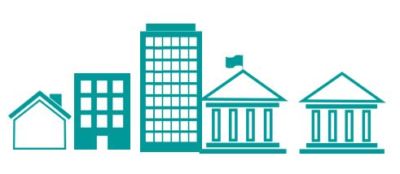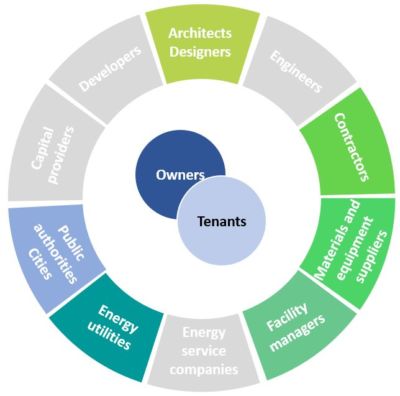Properties certified with green building label
Description
Green building certification systems assess a building’s performance based on environmental and wider sustainability criteria and provide the evidence that building procures a certain sustainability standard. Green certification can stimulate investments in renewable technologies, even when they are not cost-effective. However, it is generally efficient in niche markets because such certification is on a voluntary based.

In this business model a property developer or architect designs and builds buildings certified according to a voluntary green certification scheme, expecting to realize a sales/rent price premium compared to conventional buildings. This is frequently the case in the North American and some Asian markets.
This premium should compensate for the additional costs related to the green features of the building, and for the costs of the certification.
Drivers for an increasing demand for certified buildings include:
- Corporate Social Responsibility (CSR): green buildings are part of their green image;
- Reducing operating costs of green buildings
- Enhancing levels of comfort for building users, which in commercial buildings may lead to higher productivity and less sick leave;
- Regulation which mandates green certification, for example for public buildings, and turns voluntary schemes into mandatory ones.
Most green building certification systems cover a range of environmental and broader sustainability criteria related to energy and water uses, indoor environment and materials used. Some systems also include criteria on functionality and comfort, economic questions and innovation. Normally, a building must fulfil most of the criteria set by the certification systems.
There are a variety of voluntary certification systems globally. The most widely used are the U.S. Green Building Council’s LEED standards and the UK based ‘Building Research Establishment Environmental Assessment’ (BREEAM). There are also schemes which focus exclusively on energy related criteria, e.g. the U.S. and Canadian Energy Star label for buildings, the German ‘Passive house’ standard, the French ‘Haute Qualité Environnementale’ (HQE) stardard and the Swiss ‘Minergie’ standard.
In addition to certification systems, there are also building rating systems, which do not issue a formal certificate. These rating systems support project developers by setting clear standards on what constitutes a green building. As rating a building is cheaper than undergoing a formal certification process, rating systems are frequently used for residential buildings.
"What” (value proposition)
Added values of building with a green certification are:
- Certification gives the buyer certainty of environmental features of the building. The owner can expect lower operating costs and additional benefits such as increased comfort for building users;
- Building certification can be used for marketing / image building. Potential increase of the economic value of the asset;
- Ability to get a premium price for property certified according to a green standard;
- Reduced operating costs of green buildings;
- Enhanced levels of comfort for building users, which in commercial buildings may lead to higher productivity and less sick leave;
- Regulation which mandates green certification, for example for public buildings, and turns voluntary schemes into mandatory ones.
"Who” (target customer)
 Green certification-based business models can be done in all market segments, i.e. for new and existing buildings, for commercial, residential and public properties, and for rented and owner-occupied properties. In other words, Private and public owners of existing single-family houses, multi-family buildings, apartment blocks, commercial/industrial/ institutional buildings, building owner portfolio.
Green certification-based business models can be done in all market segments, i.e. for new and existing buildings, for commercial, residential and public properties, and for rented and owner-occupied properties. In other words, Private and public owners of existing single-family houses, multi-family buildings, apartment blocks, commercial/industrial/ institutional buildings, building owner portfolio.
Special focus shall be done on the real estate market segment: high-end office properties located in central business districts of large cities, corporate headquarters of multinational companies but also newly built public buildings are typical examples of buildings designed and built according to the highest level of certification. Originally, most certification systems have focused on certification of new properties. Today, most certified green buildings space exists in commercial buildings, and a significant proportion of the certification is in existing buildings. For residential buildings, the focus continues to be on new properties. Trust and confidence of building owners in the sustainability certification and its provider shall be particularly cared for acquiring new customers (mainly through local and mass media, websites, local meetings).
"How” (value chain, activities, resources)
Key partners of the business model are:
- Owner of the building willing to make its building greener
- Architects/building developer
- Contractors/installers and product suppliers
- Energy utility/auditor
- Institution who develops and manages the certification system
Main stakeholders involved are project manager, product providers, administration and marketing personnel, renovation employees and logistics, distribution network plus sustainability certification provider.
Technologies depends on the certification scheme: all green certification schemes include energy efficiency measures. Under both the LEED and BREEAM certification systems (resp. US and UK systems), the installation of on-site renewable energy technologies is evaluated positively and contributes to the performance rating.
Key activities are renovation works, construction/project management, building inspection and energy audits, post renovation information / support to customers plus application for approval of certification body.
"Why” (revenue model and cost structure)
Cost structure: Costs are related to marketing, salary of construction/project manager, product costs, administration, travel, subcontracting plus sustainability certification cost. Certification is used to underpin and prove the building’s environmental qualities. The design and construction of certified green buildings is generally more expensive than similar developments without improved environmental properties. In addition, there are costs related to the certification itself. A property developer must thus be able to cover the additional costs via a premium to the sales price of the property.
Revenue stream: On the sale or rent of a premium building, customer payment for renovation, products purchased, detailed energy audit, commission for suppliers.





